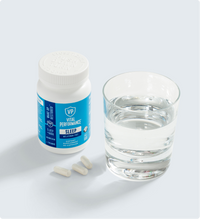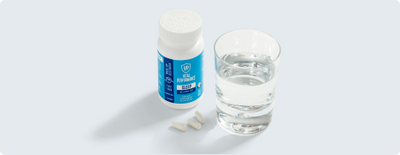Feeling worn down from the ol’ rinse and repeat? Take comfort in the fact that you’re not alone. There are plenty of people who don’t exactly hop to the shower to complete this beauty chore.
Thankfully, training your hair to go the distance between washes is possible. To help you get there, we turned to the hair pros. Follow their rules below to shave some serious time off your hair care routine.

1. Have The Right Products
Get right to the root of your hair woes by turning to your shampoo and conditioner. If you’re using one that contains deodorants, sulfates and surfactants, it’s time for a change. “These additives can be drying to the hair and cause unstable sebum (oil) production,” says hairstylist Meagen Esposito.
She recommends Verb Ghost Shampoo and conditioner as it gently cleanses without any harsh detergents.
You may also want to start off with a deep cleansing shampoo since it’ll provide the clean slate your hair needs. It’s to “deep clean all the build up, dirt and oil on the hair and scalp,” explains Nelson Chan, celebrity hairstylist and founder of Nelson j Salon in Beverly Hills.

2. Start Washing Your Hair Differently
Newsflash: You’ve probably been washing your hair all wrong.
Hollie Walter, a hairstylist and owner of Pink on Whyte, offers the advice that she recommends to her clients. “Make sure to fully saturate your hair since the hair needs to be wet enough to lather properly. From there, use only a small amount of shampoo and then lightly rinse to activate the shampoo. This will make it so that the second shampoo will lather a lot since it’s coming in contact with the previous wash.”
To get the most out of your hair-washing routine, she also recommends investing in professional salon-quality products since drugstore ones often contain wax and silicone. “This causes the hair to appear greasy from product build-up even though you just washed it,” she explains to Lively.
When it comes to conditioner, avoid applying it to your scalp area since Esposito says, “your scalp gets enough of what it needs from its natural oils.” Instead, apply it starting at your mid-strands (where a ponytail usually sits) instead and work it towards the ends. The same goes for styling products. “Pastes, serums, oils or shine products will make hair appear greasy,” she says.
3. Plan Out Your Hair A Week Ahead Of Time
Hair care is very serious business — serious enough that you should plan accordingly, advises Jana Rago, owner and lead stylist at Jana Rago Studios. “Think about what days and when you want to work out and look at your calendar to see when you have important meetings or social plans,” she explains.
“You’ll want to make sure your hair is the cleanest or easy to refresh for those important commitments. Washing your hair every day can cause long-term damage; it can dry out and become dull.”
4. Work Up To It
Remember: Training your hair to be washed less is a walk, not a sprint.
“If you usually wash every day, start small like every other day and slowly increase time between shampoos,” says Esposito. “Trying to go 4 days between washes all of a sudden can be difficult.”
Also, keep in mind that the first few weeks will be the hardest, says hair colorist, Olivia Casanova. “When you’re washing your hair every single day, you’re stripping your scalp’s natural oils which causes your sebaceous glands to overproduce,” she explains. “Not to mention, on top of drying your hair out it makes your color fade extremely fast and you’re also creating a product build-up (hello, lost shine and waxy residue).”
Simply trust the process and let your hair do the rest.

5. Avoid Touching Your Hair Throughout The Day
Your hair may look super healthy and shiny as you work through the rules, but touching it constantly does come with downfalls. “Oils from hands will make hair look greasy and stimulating the scalp will increase oil production as well,” Esposito explains to Lively.
While you’re at it, it’s recommended to let the hair air dry with minimal touching. “The more we manipulate the hair/scalp, the more we tend to activate our sebaceous glands,” says Nickie Addison, certified master colorist and owner of Nickieology Salon Studio. “If you do blow dry style your hair, always use a brush with a mineral-infused barrel and 'cool set' your blow-dry style once finished.”
Additionally, when using other hot hair tools, such as a straightener or curling iron, use a lower heat setting. Too high of heat can “weigh the hair down and dehydrate the hair over a long period of time,” explains Rago.
6. Invest In A Good Dry Shampoo
If you aren’t already BFFs with dry shampoo, prepare to get acquainted.
“In between shampoos, you can use dry shampoo to help absorb oil from the scalp and create more volume and lift,” says Chan. He recommends R+Co Dry Shampoo Spray. To use it, simply apply on the roots.
For best results, follow the best times to use it. “Try using it on day 1 of washed hair if your very oily, otherwise use it on day 2,” says Addison. And, if your hair gets messed from a sweaty workout, try this tip from Rago: “After a workout, apply the dry powder to your root and take a blow-dryer and put it on the COOL settings. Dry the hair around your part line and face.”
Don’t want to spend money on dry shampoo? Try baby powder. Like dry shampoo, it absorbs any unwanted oil, says Rago.

A Note On Greasiness
While training your hair to be washed less, you may find that things are getting worse for a while. As in, your hair might look and feel greasier than ever. When this happens, don’t panic. “It’s natural for your scalp to produce sebum, a natural oil produced by the sebaceous glands on the scalp, which makes hair look greasy in between washes,” says Chan. “Everyone produces it, and depending on hormonal changes in your body, sebum production may increase or decrease. Even very healthy hair produces sebum.”
When the greasiness feels out of hand, turn to dry shampoo. Chan also recommends Japanese rice paper. While it’s used to absorb facial oil, he says that it can also be used to absorb oil on the hair and scalp.
For those really bad hair days, try changing up your part. “For day three of unwashed hair, changing the part from the middle to side or side to the other side will give your root more volume,” says Rago.
Last but not least, give different hairstyles, such as a loose bun or braids, a try.











